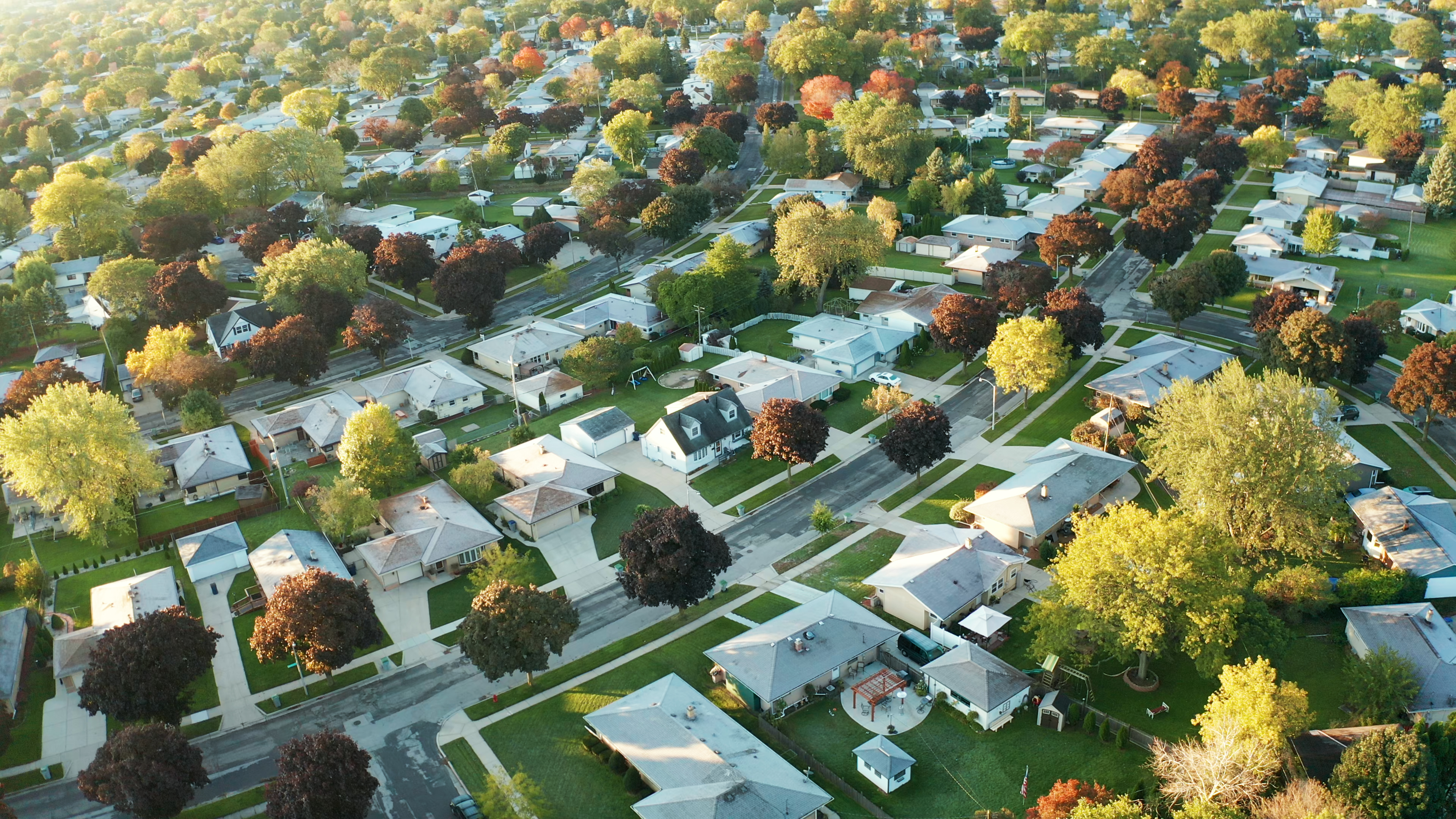Housing is a major problem in today´s societies. In the following, we discuss some elements of how the owner-occupied single-family home to which individuals aspire became what The Economist called “the West’s biggest economic policy mistake.” We argue, however, that it is more than a policy mistake and that we have to reflect on our dreams and fears to grasp the magnitude of the mistake.
Since Sigmund Freud’s foundational work on psychoanalysis, we have known that our dreams are the royal gateway to our unconscious. Psychoanalysis builds upon the idea that dreams try to fulfill a deep desire. And while houses are made of brick and mortar, they are also made of dreams and fears. A home is not only a piece of real estate to buy and sell; it is in most cases part of a person’s self-realization and charged with emotion. Societal ownership projects portray single-family homes as reachable for most people within capitalism. While other wealth components often feel virtual and literally “out of reach,” a house sitting on a piece of land promises shelter in a world of uncertainty. We argue that housing as a basic need must be liberated not only from its ideological content but also from its problematic role in personal aspirations.
We illustrate how this housing nightmare is related to the two greatest challenges faced by contemporary societies - climate change and rising inequality – and why it must be part of a solution to both. A more fearless dream of housing is urgently needed, one that will allow a focus on the housing needs of people as well as the social aspects of housing.
Homeownership in western societies
Dwellings are a place to live. They are local by nature, as they occupy a piece of land, a distinct place in the world. That distinguishes them from most other wealth components. And their common function is use, irrespective of whether a flat is rented or a house is owned (see Analysing Wealth Inequality: A Conceptual Reflection). Whether we rent or own our dwelling should not make a difference in costs given the standard assumptions in most economic models, such as strict life cycle preferences, no bequest motives, no credit constraints, and rational behavior. Economic models are often based on rational choice. Aside from the fact that these assumptions fail once economists bring them to the data, we also know from neuroscience that emotional engagement is actually a pre-condition for any means-end rationality. On top of that, from within a rational model, it is impossible to decide if it is rational to apply the model (see Lakoff and Johnson, p. 514). But clearly, we must be dreaming of homes that we own, not rent, for a reason.
During the 20th century, the single-family home became the central trademark of belonging to the rising middle class. After the second world war, real estate ownership also became a major vehicle for wealth accumulation. A large degree of wealth accumulation during this time was based on rising real estate prices, driven by rising land prices (see Knoll et al. 2017). While rising prices increase the attractiveness of investment, they at the same time undermine affordability. This makes the club of owner-occupiers more and more exclusive in the sense that it becomes more difficult over time to enter this club just by saving out of labor income. Rising house price-to-income ratios imply that young households come to rely ever more heavily on access to parental wealth for becoming homeowners themselves. An alternative is debt – often in excessive amounts. In pursuit of their dream to enter the middle class and gain the security promised by homeownership, households take up large amounts of debt, betting everything on a single asset powered by high leverage. What sounds like the business of a hedge-fund, has become the only way for many people to realize alleged upward mobility by entering the realm of homeownership.
Nevertheless, homeownership rates are remarkably stable. At the same time, levels of wealth and income become better and better predictors of being a homeowner (Fessler and Schürz 2020b). Low rates of homeownership in a society are also associated with high wealth inequality. The development of housing markets directly influences the distribution of wealth. Inelastic housing supply combined with elastic lending possibilities of financial institutions make the housing market particularly volatile. Housing market bubbles have been at the center of many financial crises.
From a naïve static perspective, it seems that housing wealth makes the distribution of wealth more equal because housing assets are more equally distributed than other forms of wealth. And this empirical fact allows conservative discourses to link private property ambitions to social justice principles. Conservatives proclaim that their ideology combines an economic rationale of asset building with a fight for fairness. They present housing as a way to mitigate wealth inequality. Thus, a rare combination of material and immaterial values makes real estate particularly interesting for economic policy approaches. Sebastian Kohl shows differences in homeownership ideology by analyzing party manifestos (Kohl 2018).
The UK housing revolution provides an example, where the welfare state and the working class were weakened by Margaret Thatcher’s project of a homeownership society. It played off individual asset-building against collective welfare. A homeownership society aims at a two-class society, owners and capitalists, but not a classless society. The idea is that making people homeowners will make them more ready to support the interests of owners in general, even though their share in wealth is comparably small and does not include access to income and does not generate the power that capitalists derive from their business wealth.
Declining ownership rates in recent years for the first time in decades show this. 9 million homeowners in the United States went through a foreclosure, surrendered their home to a lender, or sold their home out of distress between 2006 and 2014. As wages stagnate and real estate prices rise, young people have increasing difficulty affording a home. Capital gains in the real estate market have been reached at the expense of the welfare positions of renters. The renters are seeing more of their incomes eaten up by higher rents.
Young people cannot afford to leave their parents, and if they do, they have to move into expensive rental apartments. But usually they have to stay at home with their parents for longer than they would like.
How dreams and family values help enact homeownership as salvation
The wealth component of the main residence allows for combining family values and real estate monetary market value. It links dreams of security with illusions of freedom. As houses are localized, this form of private property can take an imagined place of refuge and independence. Even if a suburban home is far from the dream of riding a white horse through wide-open spaces, the house nevertheless belongs to its owner and can provide a feeling of security. The saying “my home is my castle” or in its original form from the 16th century, “a (English)man’s house is his castle” speaks directly to the idea of power, safety, and freedom within one’s own home.
Rarely will people guard memories of their financial wealth. Only seldom – in the case of ruinous hyperinflation – can one be sure that people will not forget the huge loss in savings. If a family loses its home, its refuge, this memory might likely stay for generations. And almost all people have memories of their infancy or their children in the context of housing.
As life ends, one day I will die but my house will be the place to live for my children and grandchildren – as long as it is “mine,” my privately owned property. Thus, family values favor private property projects right from the beginning and weaken societal considerations. For a conservative political homeownership project, this is a huge advantage.
However, differences in homeownership rates across countries and clearly varying housing markets cross-nationally underline that there is a choice of policy options. Politics may promise to strengthen the middle class of society by firming certain values or may concentrate on social housing. Thus, in theory, housing could be part of several political approaches, since it is open for diverging emotions.
Our emotions guide our actions. Policies influence emotions in a subtle way. Homeownership is a crucial part of the American dream. This vision guides dreaming in a direction: avoidance of “Unbehaustsein”. The German word “Unbehaustsein” – literally “being with no-home” – describes the feeling of having no home that is characterized by a missing sense of belonging and a certain degree of rootlessness. The conservative discursive strategy lays its ideological emphasis on security and not on solidarity. Therefore, not belonging, not having a place, not owning a home, is dangerous. Owning a home shows that you belong to, and are a valuable part of, society.
In Red Vienna in 1919, a huge public housing program was financed by luxury taxes and real estate taxes. The dream of the working class was to have a common living space, cultural facilities, and a certain level of wellbeing. Private property was not part of their dream. However, such radical political approaches remained exceptional in history.
The improvement of living standards of the poor is not at the center of policy considerations; instead, political messages concentrate on turning poor people into small owners. As Friedrich Engels wrote in 1872 in “The Housing Question”:
“The worker who owns a little house to the value of a thousand talers is certainly no longer a proletarian, but one must be Dr. Sax to call him a capitalist.”
Emil Sax was an Austrian economist of the second generation of the Austrian school and a liberal politician. In the judgment of Friedrich Engels, he remained anchored in bourgeois thinking. To study housing does not allow us to talk about the whole wealth distribution, but only about certain parts of the wealth distribution. The rich remain missing in the considerations since housing forms only a rather small part of their portfolio. A focus on housing alone allows for a public debate on the middle class while avoiding more radical ideas of redistribution. It serves ideological purposes as it compresses a distribution with a skewed right tail and guides our vision to the middle and to a more common asset.
Kids dream of epic fights against dragons, of becoming a princess or a king. They dream about heroic developments in their lives. But the dream of homeownership is not born out of feelings of greatness; it is born out of fear. Not belonging is bad, but becoming homeless is a horror scenario, not only in times of a pandemic. Owning a home means to be safe in the sense that one is freed from the shackles of periodic rent payments and periodic contract restatements as a precondition for staying in the place one calls home. In most countries, ownership in the form of a home is also treated legally as more worthy of protection than other forms of ownership.
The psychological advantages of homeownership are evident. People can pass it on to their children and this follows family values (Fessler and Schürz 2020a). For thousands of years, humans have been conditioned to find food and shelter as primary goals in order to survive. If their fulfillment is questionable, humans react with fear and major stress.
Fear is the emotion that characterizes much of our lives. The ownership society provides, at first glance, a convincing narrative to overcome fear that is also tied in with positive and accessible family values. Privacy is important for all of us. It gives power to the people. A lack of privacy gives power to other people. Homes are a symbol of privacy.
As space is limited, so is housing. Home prices can go up, but the land they are built on and refer to is limited. This limitation makes the concept of real estate more understandable than financial wealth prices. The limitless accumulation of shares is scarier for people than the inherent limitation of houses. For the same reasons people also struggle and are intimidated by money creation or exponential growth. Wealth inequality is far greater than inequality of housing wealth. The most expensive residence in the world has a value below USD 1 billion while share prices can sky-rocket.
Private housing strengthens the anti-meritocratic element in society as real estate will be passed on and improve the wealth position of some and relatively deteriorate it for others. Recently, Harvard Economist Stefanie Stantcheva tweeted about the somewhat surprising finding of her research that people hold both contradicting beliefs:
“that it’s fair that children start from a level playing field and that parents pass on wealth tax-free.”
Such psychological family mechanisms related to the intergenerational dimension of real estate dampen claims for equality of opportunity and justice. But equality of opportunity is by far not the only problem that makes the dream of the single-family home a nightmare for society.
Safety dream for some individuals, nightmare for society
It is unclear if it was ever good for society that almost everybody was striving for a single-family home. What is rather obvious is that in combination with other challenges our societies face today, such as aging and climate change, the dream of a single-family home has become a major problem – and likely one that is hard to fix, because it has already taken rather deep roots in our minds. There are now many claims that the focus on the single-family home has been harmful, but we are not aware of any attempts that policymakers are engaged in correcting this fallacy by tackling it directly. Nobody seems to be brave enough to take on people’s dreams – even if they are clearly harmful.
On January 16th, 2020, The Economist featured an article titled, “Home ownership is the West’s biggest economic policy mistake” and subtitled, “it is an obsession that undermines growth, fairness and public faith in capitalism.” The authors describe how a shift in public policies in the 1950s started to favor owner-occupation over renting by using tax breaks, subsidies, and sales of public housing. This approach was favored by right-wing politicians for reasons of “encouraging responsible citizenship” and by the left for “nudging poorer households to build wealth”. Among many others, they bring in the NIMBY (not in my backyard) argument against owner-occupation, which basically means that owner-occupiers try to stop any form of development around them in order to protect the value of their own home and the surrounding area. They also claim that especially the “young people’s view that housing is out of reach—unless you have rich parents—helps explain their drift towards ‘millennial socialism’.”
And the World Social Report 2020 of the United Nations “Inequality in a rapidly changing world” argues that, “…securing housing and land rights, in particular, is a must. Governments have often exacerbated housing crises, instead of resolving them, by cutting back funds for social housing and failing to intervene to control property and land speculation” (United Nations, 2020, p. 123). Henry George was aware of the fact that society subsidizes all those who own the land. Even though many economists across all camps – among them Milton Friedman, Robert Solow, and Joseph Stiglitz – have endorsed parts of his ideas, only a small group of libertarians still argue for the radical tax ideas he invented (Foldvary 2005). It is however widely accepted that better access to public transportation, infrastructure, and public goods in general translates to higher prices for those who already own, while it increases rent and lowers affordability for those who do not. Adair Turner was clear about that:
“There is indeed a strong case in principle for taxing either land values or the gains from their appreciation. Land value appreciation produces wealth accumulation unrelated to the process of innovation or capital investment that drives economic growth, and rising urban land prices are a very major contributor to the rising wealth inequalities that Thomas Piketty has described. But while the case from land taxation was first made by the economist Henry George more than 100 years ago, few tax regimes reflect its strength” (Turner 2016).
The main story is easy to sum up:
50 years ago, a single-family home was typically occupied by a family, often spanning at least two generations. Today, houses tend to be heavily underused due to increases in longevity, women’s emancipation, higher mobility, and urbanization. Often excessively large houses are occupied for decades by an elderly couple or single-person household. This is not only economically inefficient and fosters social exclusion, loneliness, and depression among the elderly, but it is also an ecological nightmare as sparse housing development is not only a waste of space but also a waste of energy and infrastructure. But that’s not all. Housing is organized in a way that counteracts green policies and is often harmful in social respects. Consider the endeavor to give suburban single-family homes access to the public transportation system as a green policy of a city. Not only does it become more expensive and inefficient because of the sparsely populated areas of underused homes, but it also increases the value of those owner-occupied suburban homes and fosters inequality. The same is true for subsidies helping owner-occupiers to improve their homes to make them more energy-efficient. While the goal of greening the use of these homes is certainly well-intentioned, it cements and fosters urban sprawl, which is a way of living that is in principle neither environmentally nor socially desirable.
Instead of further subsidizing urban sprawl, measures to fight both climate change and rising inequality would need to favor more flexible and more densely populated housing solutions. Such a policy program would also allow for more public space and local recreation areas without the usual pressure to consume. When young people move out of their parental home, they usually want to live alone or with friends. In the next stage of life, couples and changing relationships are the norm. Most people at some point have a family and children. But after a few decades, the children leave home and often live in different forms of households and patchwork families until people get older and tend to live in couples or alone once more. In short, the single-family home which is tailored for the classical standard family and the large multi-generational household does not fit current western societies where a vast majority of households consist of one or two adults. In the US, the share of single-person households grew from about 5% in 1960 to more than 30% today. The share of family households of the classical married couple type decreased from about 80% of all households in 1950 to below 50% today (see Historical Households Tables).
Homeownership also reduces mobility. Spain and Italy, both countries with relatively high rates of homeownership and relatively small markets for affordable rental housing, have to deal with the problem that the young find it rather hard to leave parental households as affordable rental housing is scarce.
Home is a set of memories. Home is the historical record of the family who came before us. But in the case of private property, it transcends into the future with other family members, namely children and grandchildren. For those who lack the means for buying a house their dream of being able to buy one in the future stays alive. Even when mortgages may be a heavy financial burden, the dreams of a better life for one’s children will continue to exist.
A home creates a sense of identity, which makes the home important for politics. This link to identity may be even stronger than the one to class or rights. Home is where emotions are. Home means the place you come from: where you grew up, and to which you return for family celebrations and in your memories. Our identity is developed through our emotions and identity is tied in with having a home. People live in a place with a specific history.
And home has become a place of work for many more people. A private place becomes a labor income-earning asset. As homes are increasingly becoming workplaces and the places from which we do our banking business, etc., our homes become subject to an ambiguous domestication of work and commodification. Tensions over the meaning of home will intensify during this pandemic. As people feel depressed and develop all kinds of fear and anger some people will support measures to exert greater control over their homes, to strengthen gated communities. This will reinforce the idea of private property while the danger of being without a home increases.
Deregulation to make private real estate markets cheaper would likely turn out to make things worse since such policies encourage shorter rental contracts and create a general increase of uncertainty for the renters, which in turn increases the fear of losing one’s home. As we argued above, the fear and potential of losing one’s home is crucial for housing decisions. To replace the single-family home in the dreams of the people one has to offer something that provides feelings at a similar level of security, freedom, and independence.
We have to dream big to solve housing problems. This means strengthening the dreams of hope and not those born out of fear. As we are bitterly learning in the pandemic, communal solutions are crucial when it comes to existential threats.
What we would need is a new sense of home. A sense of being at home can come from many sources. And people can create a shared sense of home together. Perhaps we can learn from the legacies of Red Vienna, the hometown of Freud, a city that remains among the most livable cities in the world. In Vienna, the share of social housing is about 43%. While about 22% of households live in apartments directly owned by the municipal government, 21% live in social housing provided by limited-profit housing associations. Rents, which are cost-based, are on average 23% lower than for-profit sector rents (OECD 2019).
References
Fessler, P. and Schürz, M. (2020a): Inheritances and equal opportunity - it´s the family that matters, Public Sector Economics, vol 44, no 4, p.463-482.
Fessler, P. and Schürz, M. (2020b): Structuring the Analysis of Wealth Inequality using the Functions of Wealth: A Class-Based Approach, NBER Chapters, in: Measuring and Understanding the Distribution and Intra/Inter-Generational Mobility of Income and Wealth, National Bureau of Economic Research, Inc., forthcoming.
Foldvary, F. (2005): Geo-Rent: A Plea to Public Economists, Econ Journal Watch (2005): 106-132.
Kohl, S. (2018): The political economy of homeownership: a comparative analysis of homeownership ideology through party manifestos, Socio-Economic Review.
Knoll, K., Schularick, M., and Steger, T. (2017): No Price Like Home: Global House Prices, 1870-2012, American Economic Review, 107, No. 2, pp.331-353
Lakoff, G. and Johnson, M. (1999): Philosophy in the Flesh. The embodied mind and its challenge to western thought. Basic Books.
OECD (2019), OECD Economic Surveys: Austria 2019, OECD Publishing, Paris,
Schürz. M. (2020) Überreichtum. Campus Verlag Frankfurt/New York.
Turner, A. 2016: Between Debt and the Devil – Money, Credit and fixing Global Finance Princeton University Press, New Jersey.
United Nations 2020: World Social Report 2020: Inequality in a Rapidly Changing World, Department of Economic and Social Affairs.






